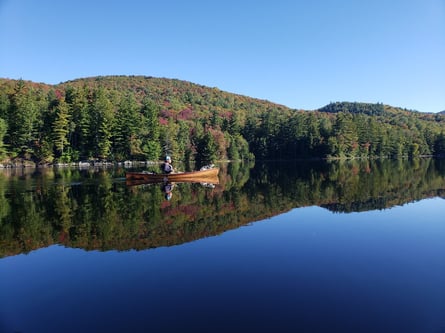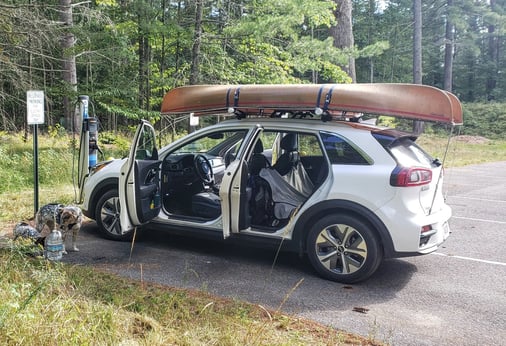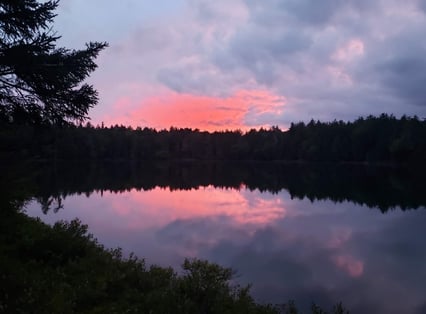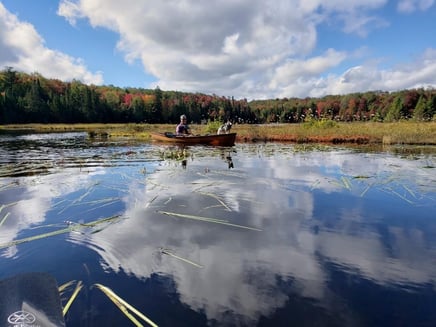
For the past three years, my spouse and I have been enjoying our retirement by taking extended camping and paddling trips throughout the Northeast, driving our 2019 Kia e-Niro EV. In this blog, we’ll use our most recent trip as an example of a typical two-week camping/paddling adventure, discuss all the gear we pack onto and into the car, and how we avoid suffering from any range anxiety.
One of our favorite areas to visit is the Adirondack Region of New York State. The Adirondack Park is the largest park in the contiguous United States, at 9,375 square miles, or roughly 6 million acres. For paddlers, the area has an almost unlimited number of options, with streams, rivers, lakes, ponds, and bogs of every size and description. We prefer and seek out the most remote and wild settings that we can find, which tend to be located in areas designated as wilderness within the park. Maps and photos from our 2021 paddling adventure – which this blog focuses on – are here.

Charging at the Park
The EV charging network in the Adirondack Region is not very well developed and consists almost entirely of Level-2 chargers located in population centers. Up until March of 2022, there were only four DC Fast Chargers at one location near Schroon Lake, NY, and one in Keene, NY; all are located in the eastern part of the park. Both of these fast charger locations are part of the EvolveNY network, and hopefully, more will be coming to the region. There were, however, Tesla Superchargers at the Lake Placid Price Chopper, which we can’t use.
Range Reducers
If we leave Greenfield, MA with a fully charged battery, our e-Niro would normally have a 240-300 mile range, depending on the weather conditions and time of year. However, with our car loaded for a paddling adventure, the range gets reduced by about 40%, mostly due to the increased wind resistance from the two 10.5-foot Hornbeck canoes strapped to the roof rack. We also pack the back of the car with paddles, floatation devices, two weeks' worth of food, and lots of backcountry ultralight camping gear. On top of all of that, we bring our two dogs along with their supply of dry dog food, backpack saddlebags, and doggie life jackets. Luckily, the e-Niro has ample storage space.

With our car full of gear and topped with two boats, we have learned to stay off the interstates and avoid driving at high speeds, and instead stick to the slower routes to reduce the considerable wind resistance. While this adds a bit more driving time to our trips, the increase in range more than makes up for it. By slowing down a bit, we found that we could easily drive the 150-miles from Greenfield to the fast chargers in Schroon Lake, and would likely have no problem making it even further to the new fast chargers in Keene.
Camping, Canoeing, & EV Charging
At fast chargers, we typically only charge up to 80%, which would allow us to proceed on to just about any area of the Adirondack Park. On our most recent trip, our first destination was the St. Regis Canoe Area, a paddling wilderness near Saranac Lake, about 60 miles further west. Since this was our first time visiting the St. Regis area, we also thought we might want to paddle in at least one or more other areas, and we wanted to make sure we would have plenty of juice when we decided to head back home. Unfortunately, none of the existing level-2 chargers are located near the remote access parking areas where we would be starting our paddling adventures.
In the heart of the park, with nothing but slow level-2 chargers available, we’d have to carefully plan our route, but by doing some sleuthing in advance, we were able to make a connection with Scott van Laer, the Director of the Adirondack Visitor Interpretive Center (The VIC) located at Paul Smith’s College. The VIC is an awesome outdoor education center associated with Paul Smith’s College. It turns out that Scott is also an EV owner and he recently had some ChargePoint level-2 charging stations installed at the VIC which are available to the public. The VIC also provides camping (for a fee), so we were able to plug-in overnight while camping in a lean-to very close to our charging car, which gave us a full battery in the morning with full range to last us for the entire adventure, resulting in zero range anxiety. Staying at the VIC also gave us an easy first night after a long drive, with a beautiful wooded setting on a pond with an extensive marsh complex. We watched the sun set over the water while eating a hot supper.

We planned to do our first ten days of paddling in the St. Regis Canoe Area. Parking at Floodwood Pond, we did two five-day loops, resupplying back at the car in between.
Primitive campsites are located on most of the ponds throughout the area, and are available at no cost, but are on a first-come, first-served basis (no reservations). For 10-days we enjoyed the beautiful fall weather while we leisurely explored the St. Regis area. This is a very popular destination, and we did see other paddlers, but for the most part, there was a sense of solitude and plenty of beauty.
The second leg of this trip took us about 40-miles south by car to the paddler’s access below Horseshoe Lake at Low’s Lower Dam on the Bog River, which is a favorite area we’ve returned to year after year. The put-in is a short walk from the parking area and the dam creates flatwater with no discernable current.

This last paddle was an out-and-back, so we returned to the car and packed up our gear and boats. We had plenty of range left to retrace our route and do a little fast charging back at the Schroon Lake Sunoco, before heading back to Mass. There are many other areas to explore in the Adirondack Park, and by spending our first night at the VIC to top off the battery, we can easily access the entire region. We have hiked and backpacked on some great trails, doing 5 to 6-day loops around Cranberry Lake and through the Five Ponds Wilderness Area, where there are tens of thousands of acres of ancient, old-growth forests. Either way, paddling on the water, or hiking on the trails, we know we can get to the most remote areas with absolute confidence, and no range anxiety, while driving our EV.





Comments